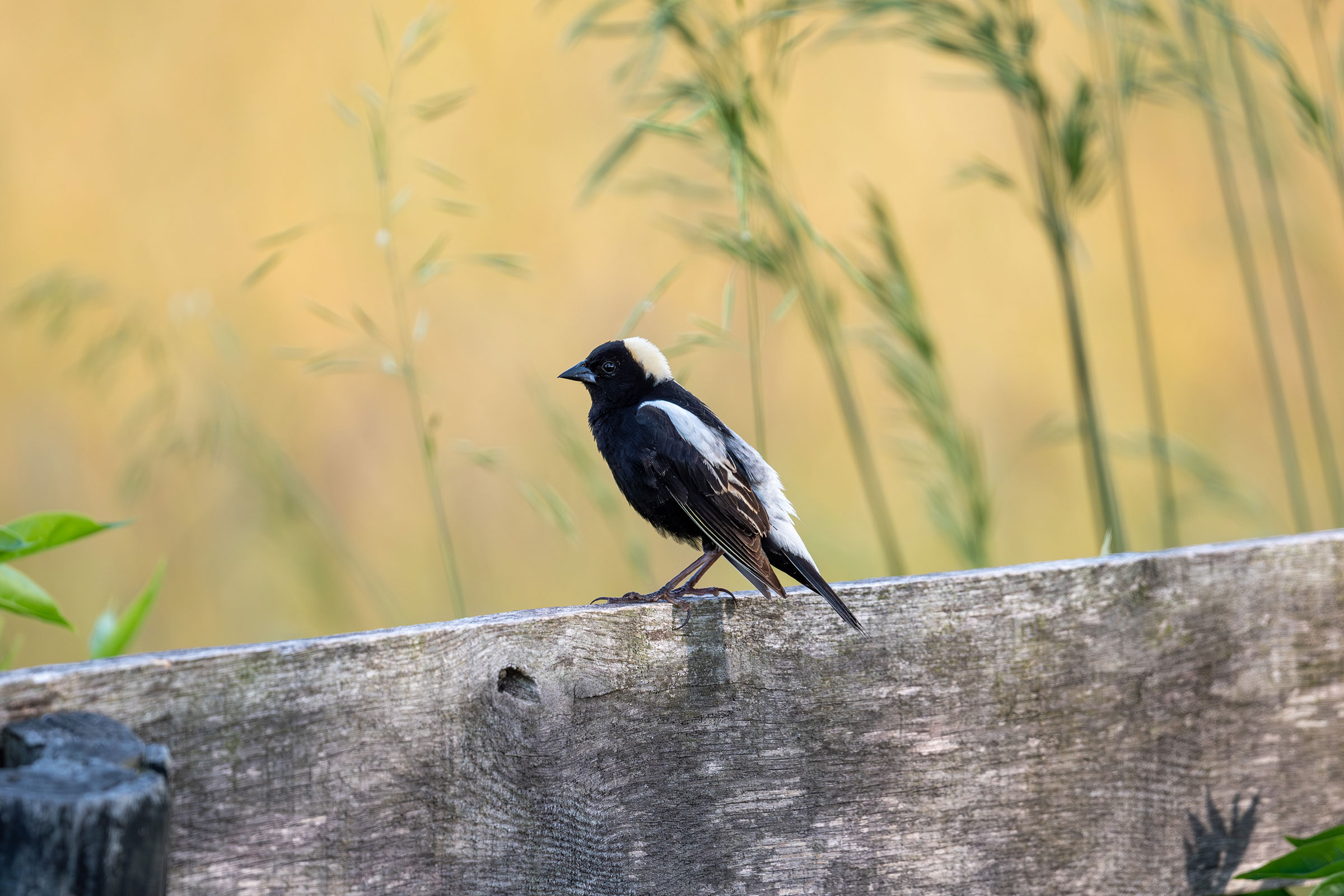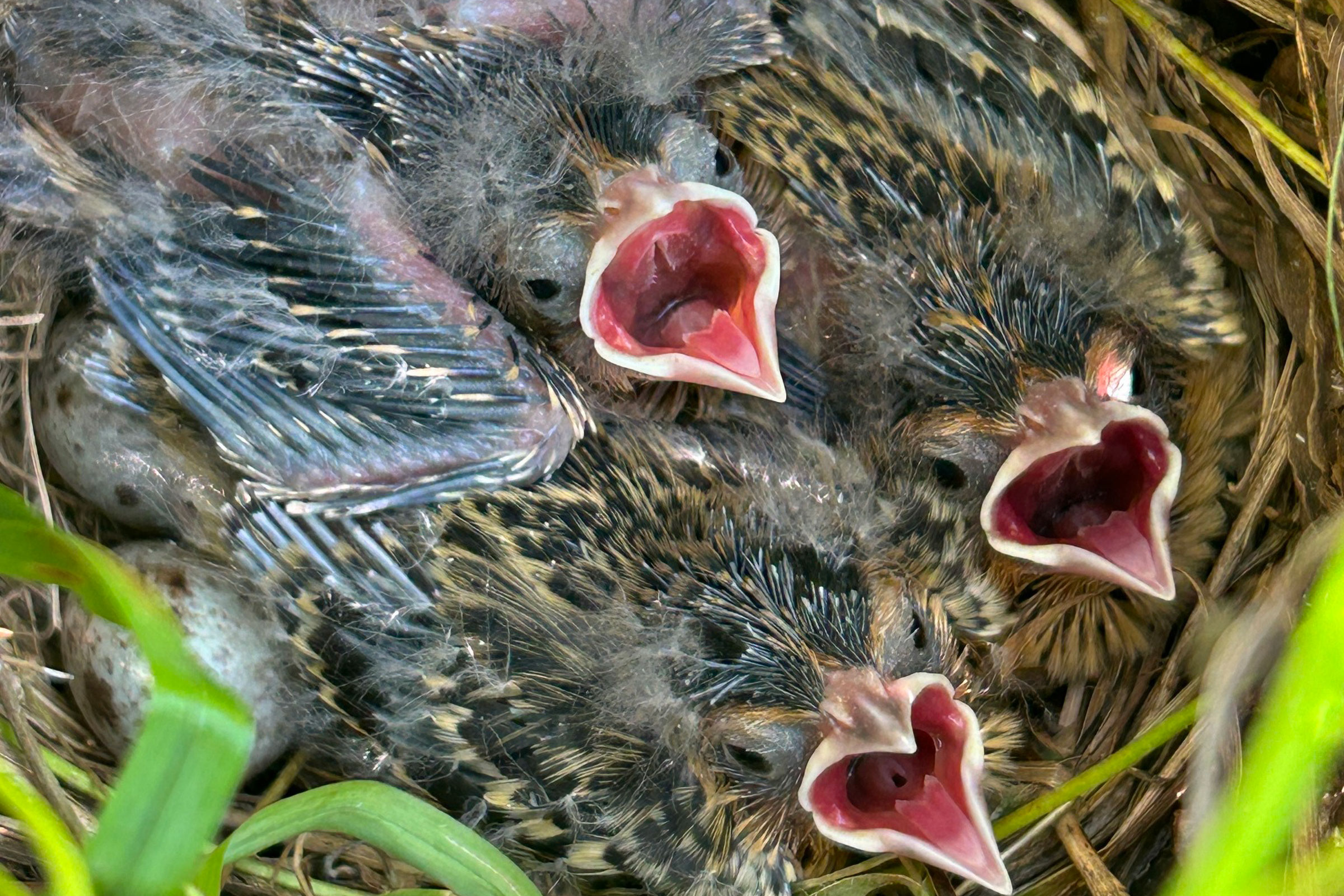Introduction
The striking white-over-black of a male Bobolink is always a delight in rural agricultural grasslands. Their bubbly songs have inspired generations of poets and artists. The Bobolink is familiar as a transient migrant outside of Virginia, particularly in fall, as populations travel more than 12,000 mi (19,312 km) to winter in Argentina, one of the longest migrations of any songbird in the New World (Renfrew et al. 2020). They are closely tied to agriculture, particularly to hayfields and pastures, while breeding in Virginia. Changes in agricultural practices have had major impacts on Bobolinks, often to their detriment, and appropriate management actions related to cattle stocking density and timing of hay harvesting are critical to their nesting success (Shaffer et al. 2023).
Breeding Distribution
Bobolinks breed only in the Mountains and Valleys and Piedmont regions; however, in the latter region, they have a low likelihood of occurrence. Breeding is most likely to occur close to the Blue Ridge Mountains, specifically in the high-elevation grasslands of Highland County and in Burkes Garden in Tazewell County, as well as in the Shenandoah Valley (Figure 1). The likelihood Bobolinks occur in a block increases with increasing elevation, and they are also more likely where there is a greater amount of agricultural lands. In the Piedmont region, they are most often found in Fauquier and Loudoun Counties. Although breeding was probable at a single site in the Coastal Plain region (see Breeding Evidence), its distribution in this region could not be modeled.
The Bobolink’s distribution the First Atlas and the change between Atlas periods could not be modeled due to model limitations (see Interpreting Species Accounts). For more information on its distribution during the First Atlas, please see the Breeding Evidence section.
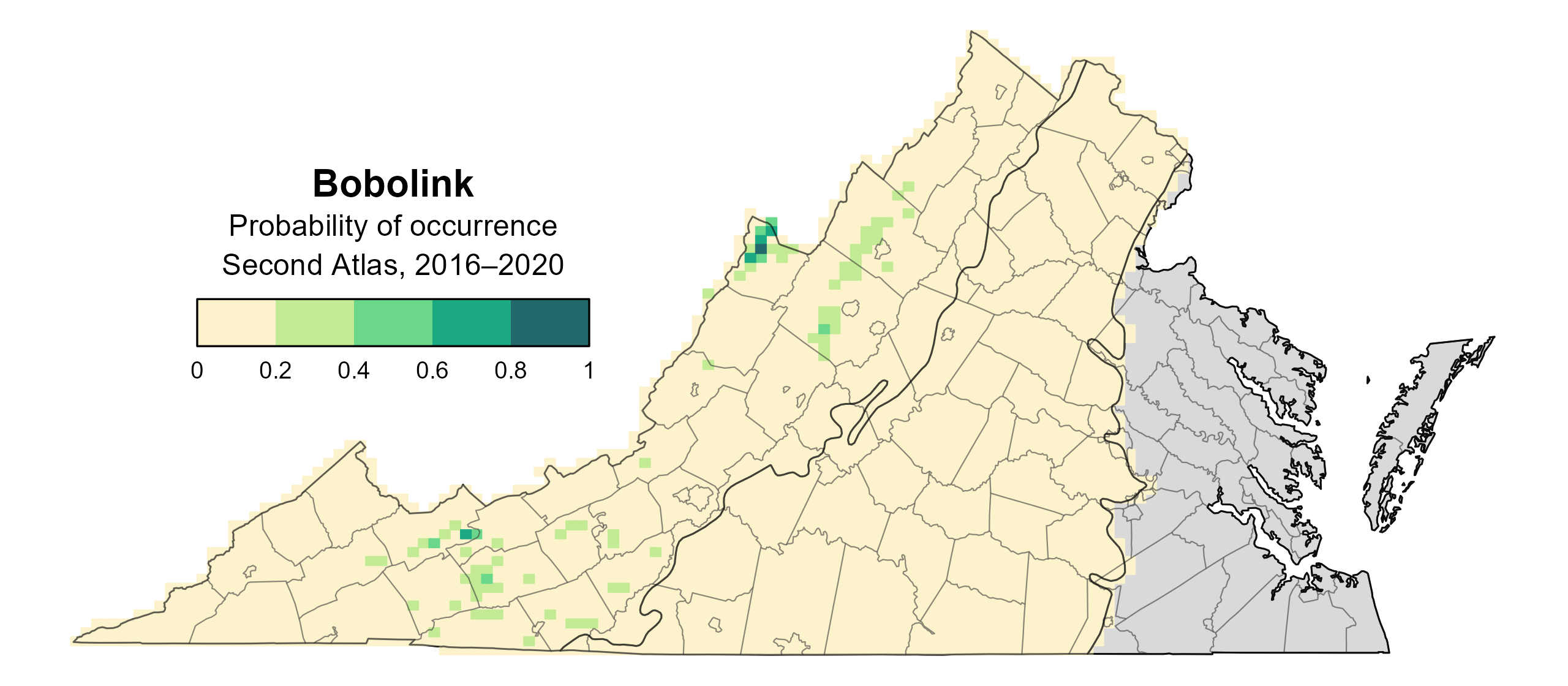
Figure 1: Bobolink breeding distribution based on probability of occurrence (Second Atlas, 2016–2020). This map indicates the probability that this species will occur in an Atlas block (an approximately 10 mi2 [26 km2] survey unit) based on environmental (including habitat) factors and after adjusting for the probability of detection (variation in survey effort among blocks). Blocks in gray are outside the species' core range and were not modeled.
Breeding Evidence
Bobolinks were confirmed breeders in 19 blocks across 12 counties (Figure 2). It was a probable breeder in an additional eight counties. One probable breeding record was found in Northampton County at Magothy Bay Natural Area Preserve, where a pair was seen copulating in late May. This was the only record in the Coastal Plain region. During both Atlas periods, volunteers observed birds in the Mountains and Valleys region and at a limited number of sites in the Piedmont region (Figures 2 and 3).
As a somewhat secretive grassland bird, Bobolink breeding was primarily confirmed through observations of adults carrying food and evidence of recently fledged young. Adults were often observed visiting probable nest sites, but nests were not often observed directly. Breeding was confirmed from May 25 (carrying nesting material) through July 28 (feeding young) (Figure 4). For more general information on the breeding habits of the Bobolink, please refer to All About Birds.
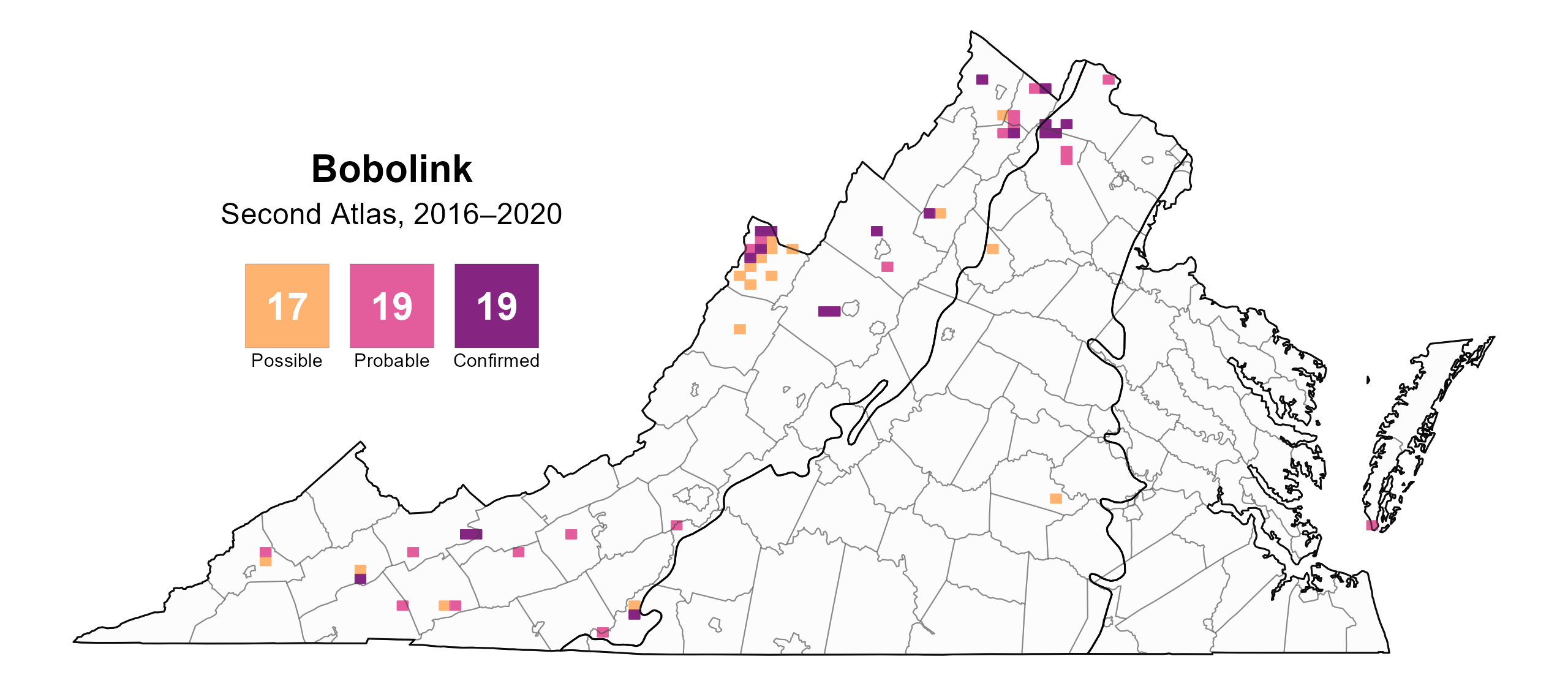
Figure 2: Bobolink breeding observations from the Second Atlas (2016–2020). The colored boxes illustrate Atlas blocks (approximately 10 mi2 [26 km2] survey units) where the species was detected. The colors show the highest breeding category recorded in a block. The numbers within the colors in the legend correspond to the number of blocks with that breeding evidence category.
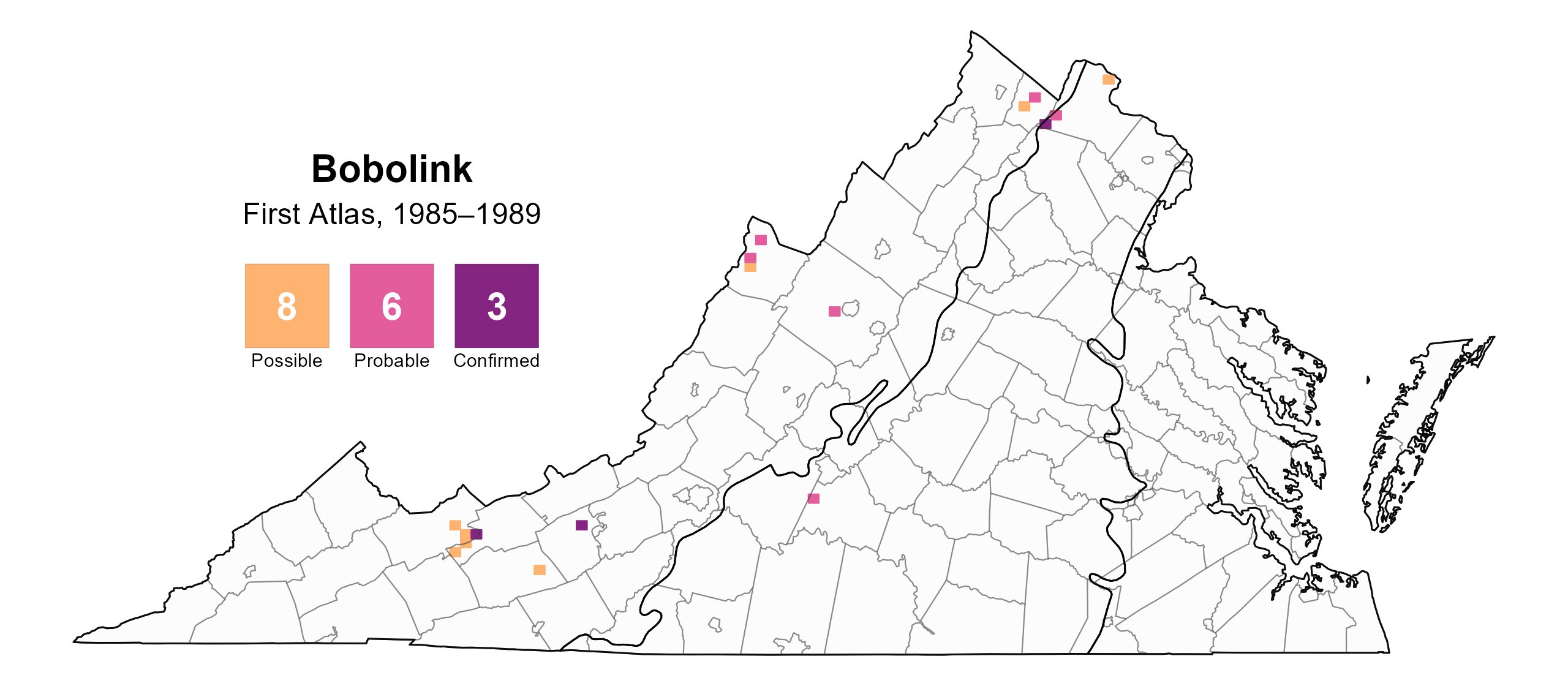
Figure 3: Bobolink breeding observations from the First Atlas (1985–1989). The colored boxes illustrate Atlas blocks (approximately 10 mi2 [26 km2] survey units) where the species was detected. The colors show the highest breeding category recorded in a block. The numbers within the colors in the legend correspond to the number of blocks with that breeding evidence category.
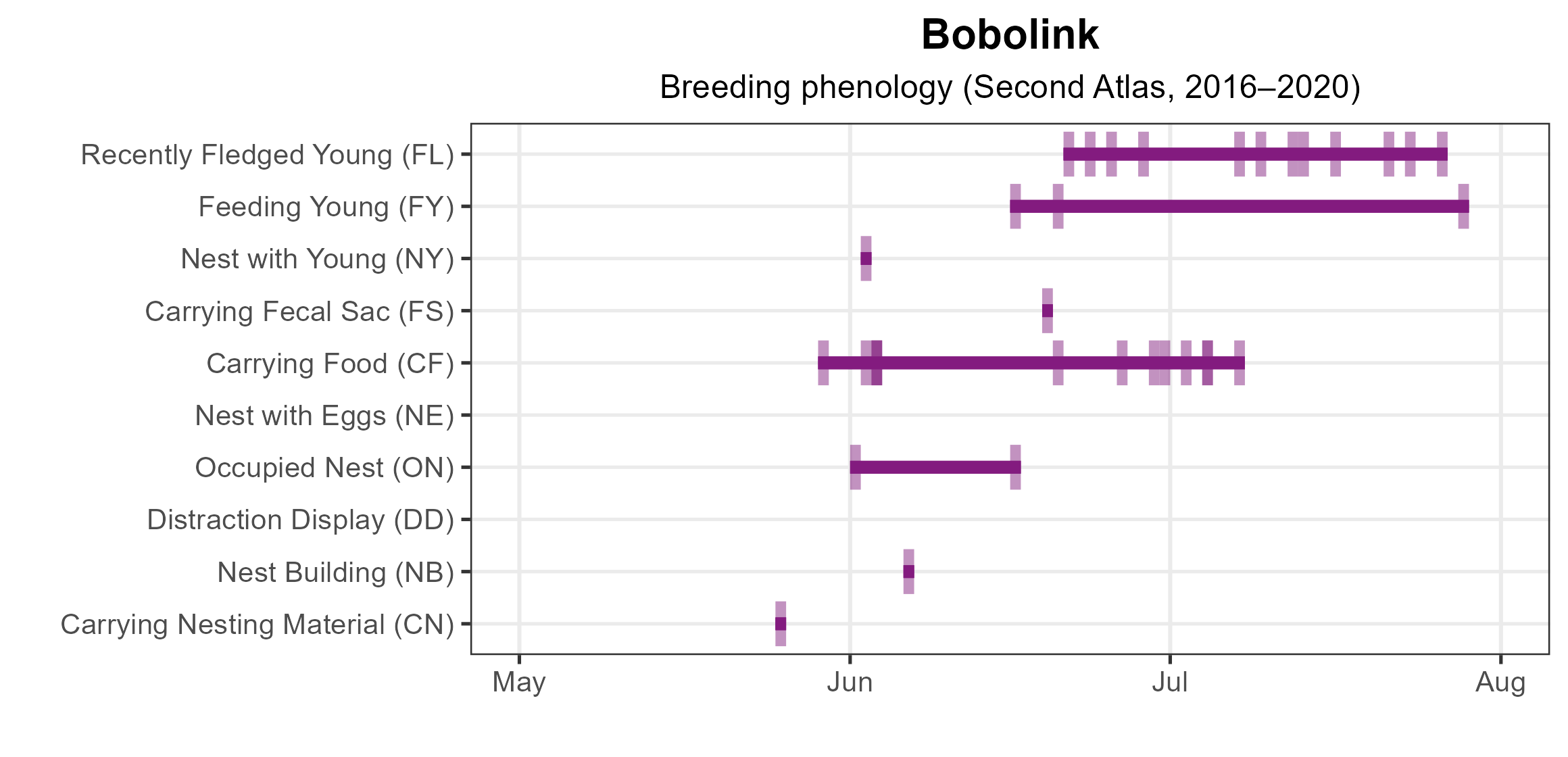
Figure 4: Bobolink phenology: confirmed breeding codes. This graph shows a timeline of confirmed breeding behaviors. Tick marks represent individual observations of the behavior.
Population Status
Bobolink populations have declined regionally, but their population trends within the state are unclear. Abundance could not be modeled from Atlas point count data because detections were limited as the species often occurs on private agricultural lands. Additionally, the North American Breeding Bird Survey (BBS) does not cover the species well in the state for this reason. However, the BBS trend for the Atlantic Flyway region showed a significant decrease of 2.73% per year from 1966–2022, and between Atlas periods, a steeper significant decline of 3.99% per year occurred from 1987–2018 (Hostetler et al. 2023; Figure 5).
It is important to note that the BBS data at this scale may not wholly reflect population trends in the state and are likely driven by changes in New England populations as the number of known breeding locations in Virginia has increased since the 1980s, with expansion into the Coastal Plain region and reclaimed mine lands in the southwestern portion of the state (Bryan Watts, personal communication).
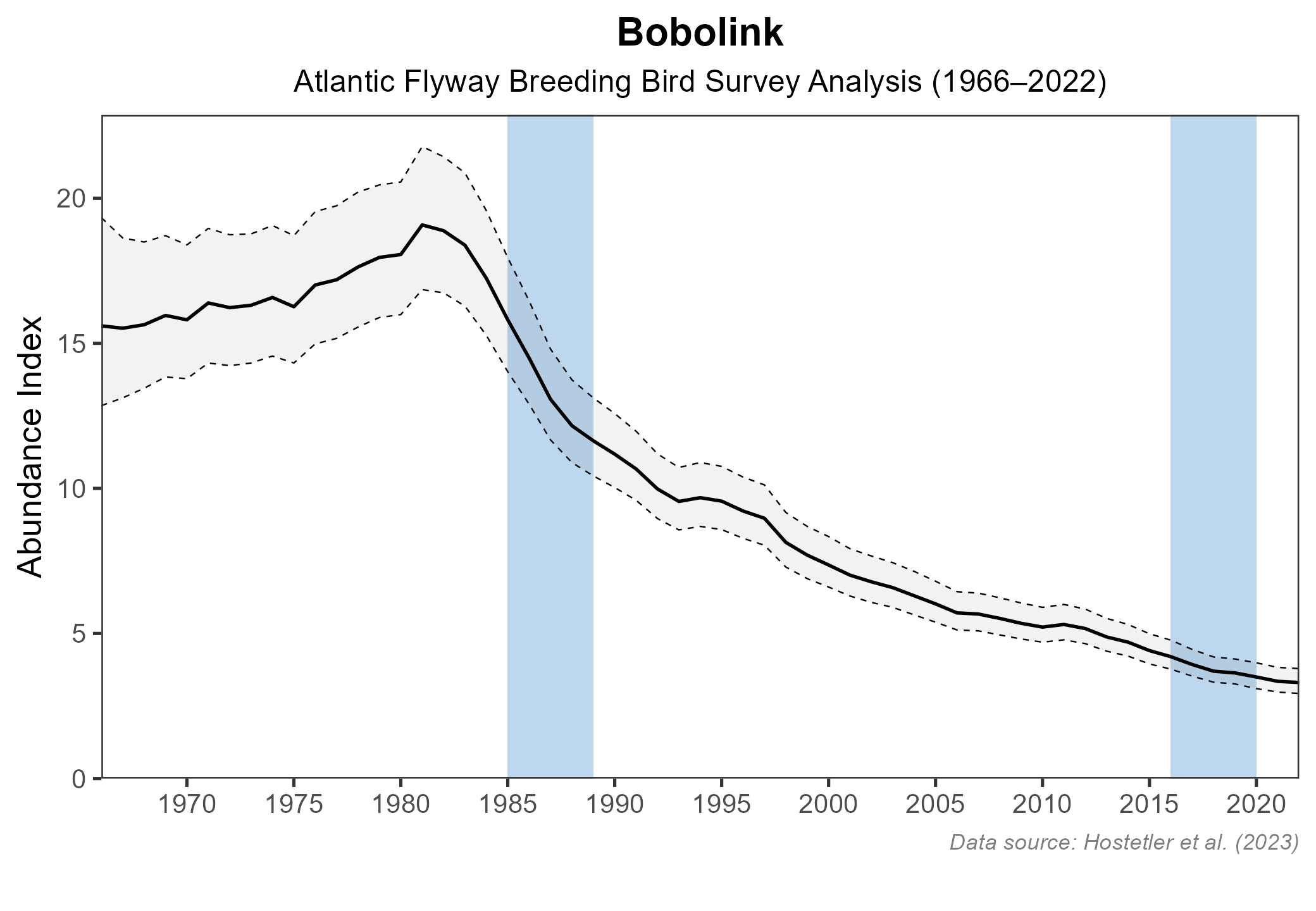
Figure 5: Bobolink population trend for the Atlantic Flyway as estimated by the North American Breeding Bird Survey. The vertical axis shows species abundance; the horizontal axis shows the year. The solid line indicates the estimated population trend; there is a 97.5% probability that the true population trend falls between the dashed lines. The shaded bars indicate the First and Second Atlas periods.
Conservation
Most Bobolinks in Virginia breed on private lands, making their situation precarious, but they are a target of multiple conservation efforts. First, they are newly listed as a Tier III Species of Greatest Conservation Need in the 2025 Virginia Wildlife Action Plan, indicating this species is at risk of extirpation within the state and actions are needed (VDWR 2025). Additionally, a collection of conservation organizations in Virginia are already working to study and conserve grassland birds on working lands, including Smithsonian’s Virginia Working Landscapes and the Virginia Grassland Bird Initiative. These groups provide resources to address grassland species declines in the Piedmont, Blue Ridge Mountain, and Shenandoah Valley regions. These resources include safe dates for haying and grazing to prevent nest failure and financial incentive programs to support farmers adopting grassland bird-friendly practices. Other groups such as the American Bird Conservancy, Piedmont Environmental Council, and Virginia Department of Wildlife Resources also provide management guidelines that encompass this species among other grassland birds (Vuocolo et al. 2016).
Interactive Map
The interactive map contains up to six Atlas layers (probability of occurrence for the First and Second Atlases, change in probability of occurrence between Atlases, breeding evidence for the First and Second Atlases, and abundance for the Second Atlas) that can be viewed one at a time. To view an Atlas map layer, mouse over the layer box in the upper left. County lines and physiographic regional boundaries (Mountains and Valleys, Piedmont, and Coastal Plain) can be turned on and off by checking or unchecking the box below the layer box. Within the map window, users can hover on a block to see its value for each layer and pan and zoom to see roads, towns, and other features of interest that are visible beneath a selected layer.
View Interactive Map in Full Screen
References
Hostetler, J. A., J. R. Sauer, J. E. Hines, D. Ziolkowski, and M. Lutmerding (2023). The North American breeding bird survey, analysis results 1966–2022. U.S. Geological Survey, Laurel, MD, USA. https://doi.org/10.5066/P9SC7T11.
Renfrew, R., A. M. Strong, N. G. Perlut, S. G. Martin, and T. A. Gavin (2020). Bobolink (Dolichonyx oryzivorus), version 1.0. In Birds of the World (P. G. Rodewald, Editor). Cornell Lab of Ornithology, Ithaca, NY, USA. https://doi.org/10.2173/bow.boboli.01.
Shaffer, J. A., L. D. Igl, D. H. Johnson, M. L. Sondreal, C. M. Goldade, A. L. Zimmerman, T. L. Wooten, and B. R. Euliss (2023). The effects of management practices on grassland birds—Bobolink (Dolichonyx oryzivorus).” 1842-LL. Professional Paper. U.S. Geological Survey. https://doi.org/10.3133/pp1842LL.
Vuocolo, C., C. Sedgwick, S. Harding, F. Wolter, S. Capel, D. Pashley, and S. Heath (2016). Managing land in the Piedmont of Virginia for the benefit of birds and other wildlife: third edition. Piedmont Environmental Council, Warrenton, VA, USA.
Virginia Department of Wildlife Resources (VDWR). 2025. Virginia wildlife action plan. Virginia Department of Wildlife Resources, Henrico, VA, USA. 506 pp.

